Native Son – January, 2013

Enchanted Rock rises majestically in the Texas Hill Country. (Note the hikers.) All photos courtesy of Steven Chamblee.
Wind, Wisdom, and King of the World
So I’m standing here on top of Enchanted Rock, this magnificent dome of pink granite that rises from the Texas Hill Country clear up to heaven. It’s 50 degrees, and this 50 mph wind is blowing so hard through my jeans that my boxers are twirling like a salad spinner. (I was going to say it feels like having a cyclone in my pants, but this is a family newsletter.) The incredible 360-degree view is so overwhelming that I close my eyes and hold my arms out like Leo DiCaprio did in Titanic, lean into the wind and yell, “I’m King of the World!” I hear a faint voice respond … surely it must be the Almighty … it says … (my nerves heighten) … it says…(my muscles grow taunt) … it says … (I don’t dare breathe) … it says … “He might be drunk, but he’s probably just old and amazed to be alive.”
I turn to find a 3-year-old boy staring tacitly at me as his “tween” sister snags his little hand and tows him back toward their parents, sneering at me the whole time. I smile and wave to the little tyke and he smiles back, waving the best he can with his free arm. Suddenly, he breaks loose from her grip and runs (in that cute little hoppy-run way that only 3 year olds can) toward the 30-somethings, arms out and hollering, “King of the World!” The sister glares back at me menacingly. Clearly, my work here is done.
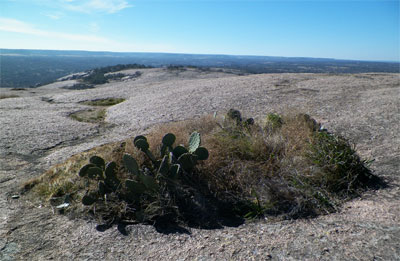
Prickly pear cactus share the rock with some dry vernal pools.
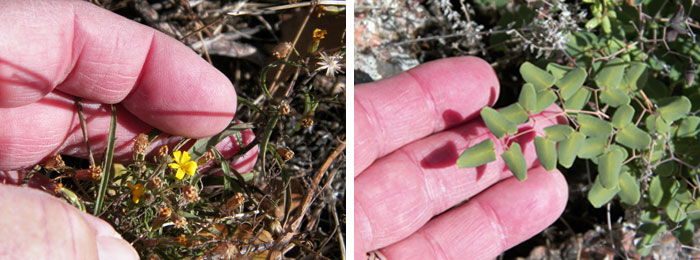
Left photo: This tiny yellow blossom was found hunkered down on the summit. Right photo: One of the many species of xeriphytic ferns that grow on the granite dome.
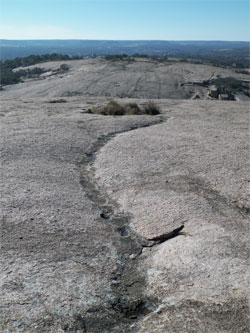
South-facing view from the summit of Enchanted Rock.
Technically, Enchanted Rock rises a mere 425 feet off the ground to an unimpressive 1,825 feet above sea level, yet it is so much more than a simple hill. This mountain has a spirit, a life force to it that vibrates my very vertebrae. As I begin the descent, my mind wanders beyond the geological (for cryin’ out loud, this thing exfoliates its skin in 2-ton flakes!), historical (Native Americans lived here some 10,000 years ago), and botanical magnificence (ferns and cactus and vernal pools … oh my!) of this place. Nearing the bottom, I sit still for a few moments and ponder what life lessons this mystical monadnock has to offer me:
Climbing the rock requires effort. For some, the climb seems easy. For others, it is more difficult. (Personally, I was sucking air like a jet engine.)
Seemingly ironic, helping others along the way actually makes the climb easier for you.
You can’t see the peak from the ground, but you climb anyway … on faith.
Best to do the uphill climb while you are fresh and young. Perseverance takes energy.
You can take the well-worn path, or not. If you choose your own way, it will be more difficult, but the journey will be uniquely yours.
It’s kind of pointless to stand there at the top all by yourself. It’s much better to share the experience with others. Breathe deep, celebrate, and then move on. Give someone else their chance to be King of the World.
The trip down is easier … more time to observe, appreciate, and explore. I found it quite natural to encourage those on their way up.
At the end of your journey, as you drive down Ranch Road 965, you’ve already forgotten about the struggles and challenges. It’s the discoveries and joys and fellow hikers that fill your memory … and your heart.
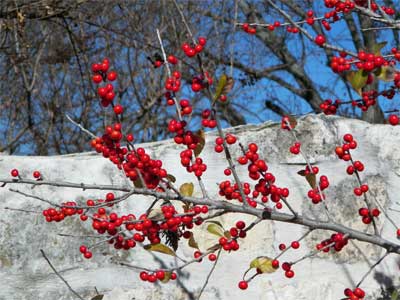
Possumhaw branch against an old limestone wall.
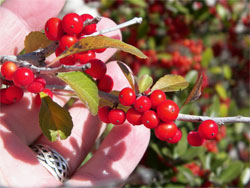
A few leaves still stubbornly cling to this possumhaw.
Not far from the park, I spot another bit of color along the fence line — the same sporadic color spots I have noticed for the last 200 miles. True enough, winter has painted the rolling landscape a wash of tan/brown/gray, but now and again there is a splash of bright orange … the sign of the possumhaw.
Native from Illinois to Virginia and southward from Florida to Texas, possumhaw can grow in a wide range of soils and habitats. Interestingly enough, I have never noticed dense populations of them in Texas (like the massive thickets of yaupon hollies north of La Grange). They just seem to be spread out over a wide area, gradually thinning as you go west.
Possumhaw (Ilex decidua) tends to confuse a lot of people, as they think of hollies in the traditional sense … wide shiny-green leaves on green twigs with lots of red berries. Though botanically a true holly, possumhaw does not resemble the other hollies, except for the tiny, rather indistinct, late-spring flowers. Possumhaws have light gray bark, a twiggy growth habit, orange fruits, and small, club-shaped, non-spiny, deciduous leaves. Truth is, most of the year possumhaws just fade into the woodlands and fence lines, never creating much of a stir. But in winter, when almost everything else turns drab, the possumhaw puts on a show … or rather, the females put on a show. Like all hollies, possumhaws are dioecious, and have separate male and female plants.
But the real magic of a possumhaw comes to light when you take it out of the woods and put it in a garden. Suddenly, that silly common name becomes impertinent, the light gray bark becomes a highlight, and that twiggy growth habit turns into sculpture. That 12-foot tall, multi-trunked, drought-tolerant, tough-as-nails native lights up a winter garden with cheery orange fruits so carefully arranged along the stems that you might think Martha Stewart is filming nearby.
Hmmm … perhaps I could learn a thing or two from the possumhaw:
Be modest most of the time.
Take advantage of your personal growth habit.
Be tough, reliable, and a friend to the bees.
Create a sensation when the time is right.
Throw an early spring party for the north-bound cedar waxwings, complete with a berry banquet.
Then let someone else be King of the World for a while.
About the author: Steven Chamblee is the chief horticulturist for Chandor Gardens in Weatherford and a regular contributor to Neil Sperry’s GARDENS magazine and e-gardens newsletter. Steven adds these notes:
Start your new year right with a visit to Chandor Gardens. Winter exposes the bones of the garden, and colorful birds make bare branches an ever-changing display. Just take I-20 west to exit 409, hang a right, go 2.1 miles and hang a left on Lee Avenue. Head straight 12 blocks and you’re driving in the gates. Call 817-361-1700 for more information. You can always go to www.chandorgardens.com for a picture tour and details.
I can always use another road trip! Let me know if you’d like me to come out and speak to your group sometime. I’m low-maintenance, flexible, and you know I like to go just about anywhere. No city too big; no town too small. Just send me an e-mail at schamblee@weatherfordtx.gov and we’ll work something out.

